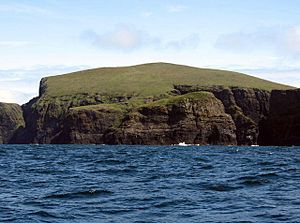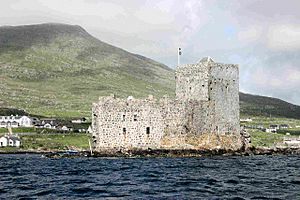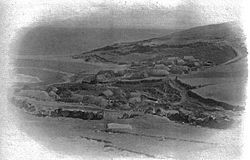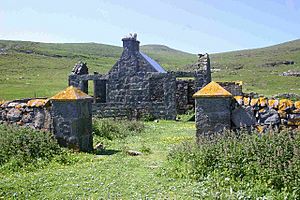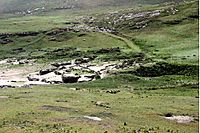Mingulay facts for kids
| Gaelic name | Miughalaigh |
|---|---|
| Norse name | Mikil-ay |
| Meaning of name | Old Norse for 'Big island'. |
| OS grid reference | NL560830 |
| Coordinates | 56°48′41″N 7°38′15″W / 56.8115°N 7.6375°W |
| Physical geography | |
| Island group | Uists and Barra |
| Area | 640 ha (2+1⁄2 sq mi) |
| Area rank | 67 out of 162 |
| Highest elevation | Càrnan, 273 m (896 ft) |
| Administration | |
| Sovereign state | United Kingdom |
| Country | Scotland |
| Council area | Na h-Eileanan Siar |
| Demographics | |
| Population | Uninhabited since 1912 |
| Largest settlement | The abandoned 'Village'. |
Mingulay (Scottish Gaelic: Miughalaigh) is a beautiful island in the Outer Hebrides of Scotland. It is the second largest of the Bishop's Isles. Mingulay is located about 12 miles (19 km) south of Barra. It is famous for its many seabirds. Birds like puffins, black-legged kittiwakes, and razorbills make their homes here. They nest on the tall sea-cliffs, which are some of the highest in the British Isles.
People have lived on Mingulay for over two thousand years. The island's culture was shaped by early Christianity and the Vikings. From the 1400s to the 1800s, it was part of the lands owned by Clan MacNeil of Barra. However, later owners did not take good care of the islanders.
In 1912, all the Gaelic-speaking people living on Mingulay left the island. It has been uninhabited ever since. Today, no sheep graze there. The island is also known because of the "Mingulay Boat Song". This song was written in 1938. The National Trust for Scotland has owned Mingulay since the year 2000.
Contents
Island Geology and Landscape
In the past, during the Pleistocene era, thick ice sheets covered Mingulay. These ice sheets spread from Scotland far into the Atlantic Ocean. About 20,000 years ago, the ice melted. Sea levels were lower then, and Mingulay was part of a much larger island. This big island included most of what is now the Outer Hebrides.
Over time, sea levels rose. This separated Mingulay from the other islands. The island is mostly made of a rock called Hebridean gneiss. There is also some granite. The ice left behind large rocks and clay on the eastern side of the island. Most of Mingulay is covered in peat, thin, acidic soil, or bare rock.
Island Geography
Mingulay is part of a small group of islands called the Bishop or Barra Isles. These islands are known for their rough seas. Traveling between them can be very risky. They form the southern end of the larger Outer Hebrides group.
Mingulay has one large beach on its eastern side. This is where the only village, called 'The Village', was located. There is also a tiny cove at Skipsdale. On the western side, you will find Bagh na h-Aoineig. This is a deep cut in the sea-cliffs. These cliffs are very tall, reaching up to 213 meters (699 feet) at Builacraig.
Mingulay has three large sea stacks. These are tall rock formations sticking out of the sea. They are called Arnamul, Lianamul, and Gunamul. Gunamul has a natural arch. On very calm days, boats can even sail through it. There are also several smaller islands nearby. These include Sròn a Dùin, Geirum Mòr, Geirum Beag, Solon Mòr, Solon Beag, and others.
The highest hills on Mingulay are Càrnan (273 meters or 896 feet), Hecla (219 meters or 719 feet), and Macphee's Hill (224 meters or 735 feet). Macphee's Hill is named after a sailor. He was left on the island after everyone else died from a disease. He climbed the hill every day, hoping for rescue. He survived for a year. When people returned to the island, he was given land there.
Ancient History of Mingulay
On the south-western part of Mingulay, called Dun Mingulay, you can find the remains of an Iron Age fort. There is also an ancient site at Crois an t-Suidheachain. This might have been a stone circle. In 1971, a 2,000-year-old Iron Age midden was found. A midden is like an ancient trash heap. It was found near the old 'Village'. A stone 'pebble hammer' was also found nearby in 1975.
The Name Mingulay
The Hebrides islands have been influenced by different cultures. These include Celtic, Norse, and Scots. This mix of cultures is clear in the names of places. The name "Mingulay" comes from Mikil-ay. This is an Old Norse word meaning "Big Island".
However, this name can be a bit confusing. Mingulay is only the second largest of the Barra Isles. Vatersay is actually bigger. The Gaelic names for the island are Miughalaigh and Miùghlaigh. People who spoke Lowland Scots also had names for the island. They called it "Mewla," "Miuley," "Megaly," and "Micklay." Finally, they settled on "Mingulay."
Some people also believe the name "Mingulay" means "Bird Island." This makes sense because of all the birds there.
Island History and Culture
Early Times: Christianity, Vikings, and Clan MacNeil
Early Christianity had an impact on Mingulay. For example, nearby islands have old stone slabs with crosses carved into them. However, no direct proof has been found on Mingulay yet. Around 871 AD, Vikings started raiding the Outer Hebrides more often. Viking graves have been found on other islands, but not on Mingulay. Even though there are no clear signs of Viking settlements, their presence is known. Many places on the island have Norse names.
By the 12th century, the power of Norway in the Western Isles began to weaken. In 1266, the Treaty of Perth gave these islands back to Scotland. In 1427, the Lords of the Isles gave the land of Barra and its islands to Clan MacNeil of Barra. The MacNeils even used the name of Mingulay's cliffs, Builacraig, as their war-cry.
Later, the MacNeils caused trouble with piracy. Because of this, King James VI gave some of the southern islands, including Mingulay, to the Bishop of the Isles. This is why these islands became known as the Bishop's Isles.
The people of Mingulay made their living in several ways. They fished for white fish, herring, and lobster. They also did crofting, which is a type of small-scale farming. They had land for crops and animals like sheep, cattle, ponies, and pigs. They also relied on the many seabirds. For example, they paid rent to The MacNeil with 'fatlings'. These were young shearwater chicks.
The Scottish Reformation did not reach the southern Outer Hebrides. So, Roman Catholicism remained strong there for centuries. There was no full-time priest on the island. So, local people often led church services. The island had a rich culture of songs and stories.
Landlords and Island Life
In 1840, the MacNeil lands, including the Barra Isles, were sold to Colonel John Gordon. He was not kind to his tenants during the Highland Potato Famine. He often forced families off their land to create sheep farms. However, some families from Barra moved to Mingulay instead of leaving Scotland. Mingulay's remote location was helpful then. Rents were even lowered for a few years. In 1878, Lady Gordon Cathcart took over the estate. She visited the island only once in 54 years.
In 1764, 52 people lived on Mingulay. By 1841, there were 113 residents. In 1881, the population grew to 150. Families were often large, with many children. Three generations sometimes lived in one small house. Life on the island was based on working together. Fishing, waulking (processing wool), cutting peat, and landing boats were all done as a community.
Even though it was remote, Mingulay was not completely cut off. In the 1800s, fishermen sold fish in Glasgow and Ireland. Both men and women worked in the herring fishing industry on the east coast of Scotland. Food was regularly brought to the island from the mainland.
At its busiest, the village had a mill, a chapel, and a school. But even though people had lived on Mingulay for at least two thousand years, they started leaving in 1907. By 1912, everyone had left the island.
Why People Left Mingulay
There were many reasons why people left Mingulay. In 1897, a boat from a nearby island was lost at sea. Five men died, which was more than half of that island's male population. This made the fishermen of Mingulay worried. Also, Mingulay did not have a safe harbor. This meant the island could be cut off for weeks. Loading and unloading goods was hard and dangerous. People were also becoming more aware of how isolated they were.
The harsh weather also caused constant difficulties. In 1868, a huge wave washed over a small island called Geirum Mor. It carried away all the sheep. The top of that islet is 51 meters (170 feet) above sea level! Some experts also think the people on small islands like Mingulay might not have managed their natural resources well. The population might have grown too large for the land to support.
In 1906, some families from Mingulay and other islands took over grazing land on Vatersay. They did this because they had no land of their own. Lady Gordon Cathcart took them to court. But the judge felt she had not done her duty as a landowner. He said her neglect had pushed the islanders to their limit. Vatersay had safe places for boats and was close to Barra. One man from Mingulay said it was better to die on Vatersay than to suffer the hardships of Mingulay.
In 1907, more families from Mingulay moved to Sandray. The problems of the Vatersay families were even discussed in the British Parliament. Eventually, the government bought Vatersay to create new farms. By the next summer, 14 Mingulay families were living there. Only six families remained on Mingulay, and they all planned to leave.
By 1910, only a few fishermen and their families were left. In the summer of 1912, the island was finally empty. Some people might have wanted to stay. But there were too few people left to keep the community going. The school had closed in 1910, which was another reason to leave. The local priest also encouraged people to leave. He found it hard to travel to Mingulay, and the church did not collect much money there.
Mingulay is sometimes called "near St Kilda". St Kilda was another remote Scottish island that was also evacuated in 1930. Mingulay is closer to the main islands than St Kilda. But a visitor in the 1800s said Mingulay was even more basic than St Kilda. This suggests that not having a good landing place was more important than how far away it was.
Mingulay Today
After everyone left in 1912, Mingulay was rented out. Then, in 1919, a man named Jonathan MacLean bought it. In 1930, it was sold to John Russell, a sheep farmer. He lived on the island alone during autumn and winter with his pet ferrets and cats. Two shepherds joined him in spring and summer. After seven years, he sold the island to Peggy Greer, a farmer from England. She rarely visited.
In 1955, a group of local farmers bought the island. They called themselves the Barra Head Isles Sheepstock Company. With motor boats, it became much easier to bring sheep to the islands. This company owned Mingulay for the next forty years.
In 2000, the National Trust for Scotland bought Mingulay. This was made possible by a gift from J. M. Fawcitt. She wanted to create a beautiful natural area to remember her parents and brother.
Today, only two buildings remain on the island. These are the old schoolhouse and the chapel house. The chapel house has lost its roof and front wall.
Island Flora and Fauna
Mingulay is home to a very large number of seabirds. It is an important place for them to breed. Many razorbills (9,514 pairs) nest here. This is 6.3% of all razorbills in Europe! There are also many guillemots (11,063 pairs) and black-legged kittiwakes (2,939 pairs).
Other birds that nest on the sea-cliffs include shags, fulmars, puffins, storm petrels, common terns, Arctic terns, bonxies, and different types of gulls. Manx shearwaters used to nest on Lianamul stack. But puffins drove them away in the late 1700s.
In recent years, metal fences have been used to limit access to the puffin colonies. This helps stop the spread of bird flu. But you can still get quite close to their burrows.
Sheep graze on the island's rough fields. There are also rabbits, which shepherds brought after the island was left in 1912. Many grey seals live here too. Their numbers have grown a lot since people left. They don't breed on Mingulay, but up to 1,000 seals use the beach in winter.
The plants on Mingulay are typical for the Outer Hebrides. You will find heather, sphagnum moss, sedges, grass, and bracken. There is only one tree on the island. It is a 2-meter high poplar tree on a cliff. Sea holly, which is rare in the Western Isles, has grown on Mingulay since the late 1800s. Sea milkwort usually grows only near the sea. But on Mingulay, it can grow on high cliff tops. This is because of the ocean spray and seagull droppings. In spring and summer, many wild flowers bloom around the deserted village.
Mingulay and nearby Berneray became a Site of Special Scientific Interest in 1983. This means they are protected because of their special nature.
Visiting Mingulay Island
Mingulay is a popular spot for people who study nature. In recent years, it has also become popular with rock climbers. The National Trust for Scotland has two licensed boatmen on Barra. You can get more information at the tourist office in Castlebay.
There is a place in Mingulay Bay where boats can anchor. It is safe from winds coming from the west. Landing on the beach can be tricky because of the waves. It might be easier to land at the old landing spot at Aneir. There is also a landing place at Skipisdale.
The Mingulay Boat Song
The "Mingulay Boat Song" was written by Hugh S. Roberton in 1938. He was the founder of the Glasgow Orpheus Choir. The Francis McPeake family first recorded it. The song is written like the work songs from the Hebrides. These songs were sung by people working together, like pulling oars. The tune is called Creag Guanach from Lochaber. The song asks you to imagine the boatmen of Mingulay singing as they row.
Chorus
Heel ya'ho boys, let her go, boys
Bring her head round now all together
Heel ya'ho boys, let her go boys
Sailing homeward to Mingulay!
What care we tho' white the Minch is
What care we for wind and weather?
Let her go boys, every inch is
Wearing homeward to Mingulay!
Chorus
Wives are waiting on the bank, boys,
Looking seaward from the heather.
Pull her 'round boys, and we'll anchor
'Ere the sun sets at Mingulay!
Chorus
Many artists have recorded this song. These include Robin Hall and Jimmy MacGregor in 1971, The Idlers and Richard Thompson in 2006, and Kris Delmhorst in 2003.
The words of the song have been changed by different artists. For example, in one version from 1961, a female singer sings the third part like this:
We are waiting by the harbour,
Weeping, waiting since break of day-o.
We are waiting by the harbour,
As the sun sets on Mingulay.
The song is very famous and reminds people of island life. However, the people who lived on Mingulay never sang it. It was written long after they had left the island.
Other songs written by or about Mingulay residents still exist. One is "Oran do dh'Eilean Mhiulaidh" (Song to the Isle of Mingulay). Neil MacPhee, who was part of the Vatersay land raid, wrote this after the island was abandoned. Another is "Turas Neill a Mhiughlaigh" (Neil's Trip to Mingulay). A priest named Father Allan MacLean wrote this. Books like Liza Storey's Miughalaigh (2008) talk about these songs and stories.
Mingulay in Books
- There is an old story that French gold was hidden in a sea cave on Mingulay's west coast. This gold was meant to help the 1745 Jacobite rebellion. This story is used in the novel Children of Tempest by Neil Munro.
- Mingulay is the name of a human colony in Ken MacLeod's science-fiction novel Cosmonaut Keep.
- In the science fiction novel 'A Boy and his Dog at the End of the World' by C. A Fletcher, Mingulay is the home of a family after human civilization has ended. It is the first place where the story happens.
See also


